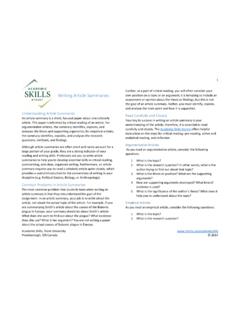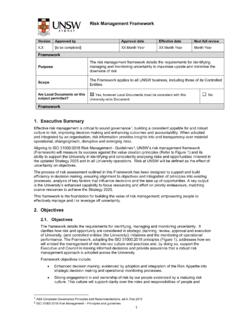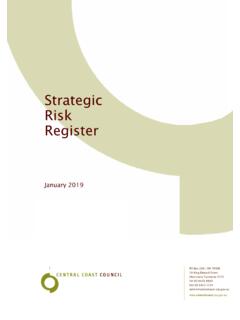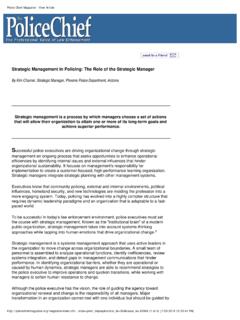Transcription of POLICY TEMPLATE ENTERPRISE RISK MANAGEMENT
1 1 POLICY TEMPLATE ENTERPRISE RISK MANAGEMENT Category: Operations Approval: Board of Governors Responsibility: Vice President, Finance and Administration Date: December 6, 2013 Definitions: Risk: is the chance that an event, trend or course of action will have either a positive or negative effect on an institution s ability to meet its strategic or operational objectives. Activity Risk MANAGEMENT : is the process of identifying, analyzing and managing risks . It provides the methodology for integrating risk into planning and decision making processes at the operational level. ENTERPRISE Risk MANAGEMENT : is the process of identifying, analyzing and managing strategic risks . It provides the methodology for integrating risk into the strategic pla nning and resource allocation processes at the strategic level.
2 Risk Analysis: is the process of determining the likelihood of a particular event, trend or course of action occurring and the impact on operational or strategic objectives if it does. Risk Tolerance: sometimes known as risk appetite, is the level of risk the University is willing to accept for any event, trend or course of action. Risk tolerance will vary depending on the potential effect of the risk on the university s operational or strategic objectives. Risk Treatment: sometimes known as risk control, is the measures used to modify the risk to fall within the university s risk tolerance for that risk. Options include accept, mitigate, transfer or avoid the event, trend or course of action. Risk Register: a list of identified ENTERPRISE risks which documents the risk analysis, risk scores, risk treatments, PVP direction, results of risk treatments and status of each risk.
3 Purpose/Reason for POLICY : The purpose of this POLICY is to: incorporate a consistent approach to risk MANAGEMENT into the culture and strategic planning processes of the University that supports decision making and resource allocation at both the operational and strategic levels. apply a consistent approach to risk MANAGEMENT to support the university s governance responsibilities for innovation and responsible risk-taking, POLICY development, programs and objectives. In all cases, appropriate measures will be put in place to address unfavourable impacts from risks and favourable benefits from opportunities. manage a transparent approach to risk through open and meaningful, pan-university 2 communication and monitoring of all key risks that balances the cost of managing risk with the anticipated benefit.
4 Scope of this POLICY : This POLICY applies to all plans, activities, business processes, policies, procedures, individuals and property that comprise the Trent University ENTERPRISE . POLICY Statement: Trent University engages in a wide range of activities, both on and off campus, all of which give rise to some level of risk. It is the POLICY of Trent University to: Embed risk MANAGEMENT into the culture and operations of the university Integrate ENTERPRISE Risk MANAGEMENT into strategic planning, activity planning, performance MANAGEMENT and resource allocation decisions Manage risk and leverage opportunities in accordance with best practices Regularly re-assess the university s risk profile and the effectiveness of risk treatments in the context of the various strategic plans Anticipate and respond to changing social, environmental and legislative requirements Responsibilities: Board of Governors.
5 Is responsible for oversight of the ERM Program to ensure that the ERM process is used to develop and achieve the strategic objectives of the University as articulated in all strategic plans. President: is responsible to ensure that all executive sponsors and risk owners integrate ERM into the development of strategic plans and operational decisions and to report on the university s ENTERPRISE risk profile to the Board of Governors semi-annually. PVP: is the senior risk committee of the university responsible to identify emerging ENTERPRISE risks , prioritize identified ENTERPRISE risks , direct or approve risk treatments, allocate sufficient resources to implement risk treatments, monitor the results of risk treatments, review and update the risk register in preparation for the semi-annual Board reports and ensure that ERM is integral to strategic goal setting and decision making.
6 Director, Risk MANAGEMENT : is responsible to manage the ERM Program. This involves monitoring sector best practices and standards, working with risk owners and executive sponsors to analyze both operational and ENTERPRISE risks and develop effective risk treatments, managing the university s insurance program, regularly updating and/or renewing the risk register and coordinating risk MANAGEMENT education and training. Risk Owners: are supervisors typically responsible for one or more university functions and are directly responsible to implement risk treatments as directed by PVP. Risk owners are responsible for maintaining good internal controls, managing their operational risks and advising their Executive Sponsor of any risks in their portfolio that cannot be managed operationally and should be submitted to the ERM program.
7 All employees: are responsible for effectively managing risks in their area of responsibility and identifying and advising their supervisor of potential risks . 3 Contact Officer Director, Risk MANAGEMENT Date for Next Review November 2018 Related Policies, Procedures and Guidelines Activity Risk MANAGEMENT POLICY Student Activity Risk MANAGEMENT POLICY Emergency MANAGEMENT Plan Health and Safety POLICY Policies Superseded by This POLICY Nil 4 APPENDIX B PROCEDURE ENTERPRISE RISK MANAGEMENT Contact Officer Director, Risk MANAGEMENT PROCEDURE Purpose The purpose of this procedure is to describe the ENTERPRISE Risk MANAGEMENT process. Procedure . Everyone 1. Identify any risks ie. Threats or opportunities affecting Trent that you are not able to effectively manage to reduce the risk of loss, or achieve the potential gains, in a manner compliant with legislation, sector best practices, Trent policies or the instructions of your supervisor.
8 2. Report these risks to your supervisor. Risk Owners (supervisors) 1. When commencing a new activity, conduct a risk assessment in accordance with the Activity Risk MANAGEMENT POLICY . 2. If you become aware of an untreated risk in your portfolio, determine the potential impact of the risk on your operation, or the university, and the likelihood of that impact to occur. 3. Determine if you should: a. Avoid the risk ie discontinue the activity giving rise to the risk if it will not negatively affect operational objectives; b. Transfer the risk ie. Hire a contractor, buy insurance etc. c. Treat the risk ie. Take additional measures to minimize losses and/or maximize gains such as altering procedures, adding physical safety measures, cross training personnel, duplicating important equipment or backing up data.
9 D. Accept the risk ie. The potential loss or gain is not significant. 4. If in doubt, seek advice from the Risk MANAGEMENT Office. 5. If you are unable to take appropriate action due to lack of resources, authority or institutional support, consider working with one or more other risk owners (departments) to treat the risk. 6. If step 5 is not feasible, report the risk to your Executive Sponsor. Executive Sponsor 1. Validate the risk analysis in light of existing strategic planning objectives. 2. If the Risk Owner s recommended treatment is appropriate, determine whether you have the authority and can allocate resources to implement the treatment. 3. If the risk is likely to affect Trent s ability to achieve one or more strategic goals, the risk is an ENTERPRISE risk.
10 Advise the Director, Risk MANAGEMENT , even if you are able to treat the risk. 4. If you are unable to treat the risk, either under your authority or in collaboration with one or more executive sponsors, add the risk to the PVP agenda. You may wish to have the Director, Risk 5 MANAGEMENT assist with a detailed risk analysis and risk score in preparation for discussion at PVP. PVP 1. Review the risk analysis and determine which strategic objectives may be affected, negatively or positively, by the risk exposure. 2. Consider the current risk tolerance level(s) set by the Board. 3. Provide direction to the Executive Sponsor as follows: a. The risk treatment to be undertaken; b. The resources available to implement the risk treatment; c.











